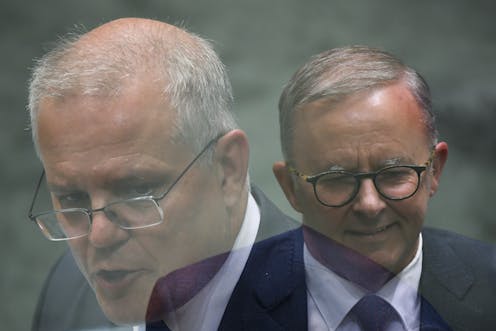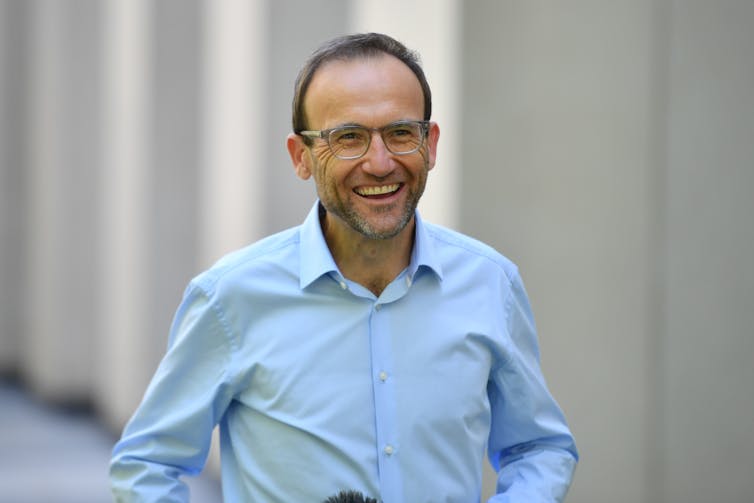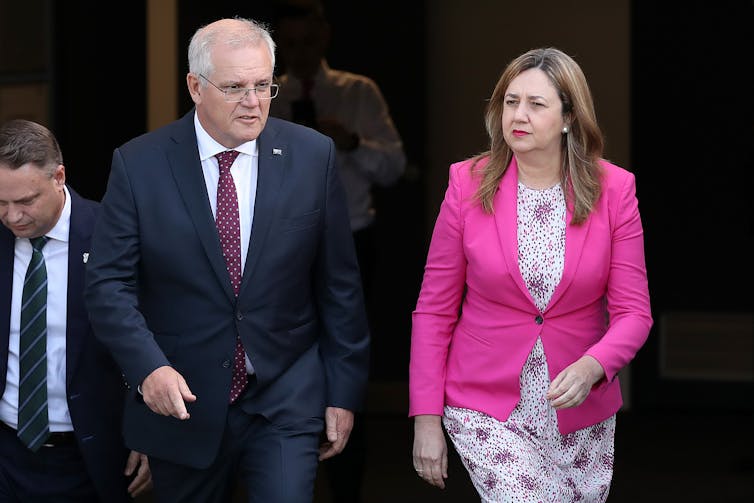
This week’s Newspoll, conducted March 31 to April 3 – the days following the March 29 budget –from a sample of 1,531, gave Labor a 54-46 lead, a one-point gain for the Coalition since the last Newspoll, three weeks ago.
Primary votes were 38% Labor (down three), 36% Coalition (up one), 10% Greens (up two), 3% One Nation (steady), 3% UAP (steady) and 10% for all Others (steady).
54% were dissatisfied with Scott Morrison’s performance (down one), and 42% were satisfied (up one), for a net approval of -12, up two points. Anthony Albanese’s net approval dropped three points to -1. Morrison edged ahead as better PM by 43-42 after a 42-42 tie last time. Figures from The Poll Bludger.
The Coalition’s one-point gain may be due to the budget, or other factors since the last Newspoll, like the “mean girls” controversy. There was a softening in Labor’s lead in last week’s pre-budget Morgan poll. The Greens’ two-point gain at Labor’s expense means they have recovered from February’s drop from 11% to 8%.
The polls overall still show a large Labor lead, but Newspoll gives the Coalition some hope. Will the polls narrow during the election campaign?
To allow enough time for senators to be declared elected by the July 1 date for newly elected senators to take their place, a half-Senate election is required by May 21 – see ABC election analyst Antony Green.
It is technically possible to postpone the House of Representatives election, but voters would not like two elections in a few months, and the Coalition would likely suffer at both elections. With a minimum 33-day campaign period, the election must be called in the next two weeks.
I expect more post-budget polls from Essential, Morgan and Resolve on Tuesday, and for the standard Newspoll budget questions to be published.

Ipsos poll: 55-45 to Labor
Before the 2019 election, Ipsos conducted monthly federal polls for Nine newspapers. After the poll failure at that election, it was booted and replaced by Resolve. But Ipsos will conduct polls for The Financial Review in the lead-up to this election. Ipsos uses a combination of online and live phone polling.
In the first Ipsos poll since the 2019 election, Labor led by 55-45 after undecided voters were excluded. Primary votes were 35% Labor, 31% Coalition, 10% Greens, 4% One Nation, 2% UAP, 8% for all Others, 7% undecided and 2% not enrolled.
The major parties would be higher if undecided and not enrolled were excluded as Newspoll does. Since there isn’t a “don’t know” box at an election, Newspoll’s figures can be compared directly with election results and are preferable.
The headline 55-45 Labor lead is derived from a 51-42 Labor lead with 7% undecided using 2019 election preference flows. A respondent allocated preference flow was 48-37 to Labor with 15% undecided, which would include minor party voters who would not say which major they preferred.
Morrison had a 48-33 disapproval rating, while Albanese was at 32-30 disapproval. Albanese was just ahead of Morrison by 38-37 as preferred PM. 29% thought they would be better off after the budget, 23% worse off and 39% no difference. This poll was conducted March 30 to April 2 from a sample of 2,563.
Morgan poll: 55.5-44.5 to Labor
A pre-budget Morgan poll, conducted March 21-27 from a sample of 1,404, gave Labor a 55.5-44.5 lead, a 2.5 point gain for the Coalition since the March 14-20 poll. Primary votes were 35.5% Labor (down two), 33% Coalition (up two), 12.5% Greens (up 0.5), 3.5% One Nation (up 0.5), 1% UAP (steady), 10% independents (down 0.5) and 4.5% others (down 0.5).
A separate Morgan SMS poll, conducted in the two days after the budget from a sample of 1,067, gave Josh Frydenberg a 46-28.5 lead over Morrison as preferred Liberal leader with 14% for Peter Dutton (38.5-31 to Frydenberg in February). Among Coalition voters, Morrison was just ahead by 38-37.5.
Newspoll March quarter aggregate data
Newspoll released its aggregate data for all polls conducted from January to March on March 25. In NSW, Labor led by 54-46, a swing of about 6% to Labor since the 2019 election. In Victoria, Labor led by 58-42, a swing of 5% to Labor. In WA, Labor led by 53-47, a swing of about 8.5%. In SA, Labor led by 59-41, a swing of 8%.
Queensland was the pro-Coalition exception, with the Coalition ahead by 54-46, though that’s still a swing of 4.5% to Labor. Labor had a 55-45 lead among both men and women, and led among all income groups. This included a 55-45 Labor lead among those on $150,000 per year income and above after trailing 53-47 in the December quarter. Figures are from The Poll Bludger.

More on seat polls
In the same post, The Poll Bludger gave his analysis of the two party vote and swings from the 2019 election for the polls of nine federal seats I discussed on March 24. In contrast to national polls, the average swing in these polls was just 2% to Labor since the 2019 election. Four of these nine seats had swings to the Coalition.
KJC Research, which conducted these seat polls, is also known as Telereach and Mediareach. They conducted a seat poll of Wentworth (NSW) for The Conversation’s Wentworth Project from March 19-21 with a sample of 1,036.
Liberal incumbent Dave Sharma led independent Allegra Spender by 51-49 from primary votes of 42% Sharma, 27% Spender, 14% Labor, 9% Greens, 3% Liberal Democrats and 3% UAP.
SA final lower house results
At the March 19 South Australian election, Labor won 27 of the 47 lower house seats (up eight since the 2018 election), the Liberals 16 (down nine) and independents four (up one). That’s a Labor majority of seven.
Read more: Labor easily wins South Australian election, but upper house could be a poor result
Vote shares were 40.0% Labor (up 7.2%), 35.7% Liberals (down 2.3%), 9.1% Greens (up 2.5%), 3.7% Family First (up 0.6% from the Conservatives in 2018), 2.6% One Nation and 8.7% for all Others – mostly independents (up 3.3%). SA-Best was down 13.9% from 2018 to just 0.2%.
ABC election analyst Antony Green said Labor won the statewide two party preferred vote by a 54.6-45.4 margin, a 6.5% swing to Labor. This is in good agreement with the two final polls, with Newspoll giving Labor a 54-46 lead and YouGov a 56-44 lead. It’s the first time Labor won the two party since 2006, even though they formed government after the 2010 and 2014 elections.
In the upper house, 11 of the 22 seats were up for election by statewide proportional representation with preferences, so a quota was one-twelfth or 8.3%. With all votes counted, Labor has 4.42 quotas, the Liberals 4.14, the Greens 1.09, One Nation 0.51, the Liberal Democrats 0.39, Family First 0.37, Legalise Cannabis 0.25 and Animal Justice 0.18
Four Labor, four Liberals and one Green will be immediately elected. Green expects Labor and One Nation to win the final two seats. Scanning of ballot papers will extend the time before the button is pressed to distribute preferences, which Green does not expect until around Anzac Day (April 25).
French elections and Ukraine
The first round of the French presidential election will be held April 10, with a run-off between the top two candidates on April 24. I wrote for The Poll Bludger Thursday that incumbent Emmanuel Macron has slumped in runoff polls against the far-right Marine Le Pen, though Macron still leads by at least five points.
A poll conducted by a UK pollster in Russia showed that Russians strongly supported the Ukraine invasion and Vladimir Putin.
Adrian Beaumont does not work for, consult, own shares in or receive funding from any company or organization that would benefit from this article, and has disclosed no relevant affiliations beyond their academic appointment.
This article was originally published on The Conversation. Read the original article.







